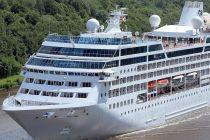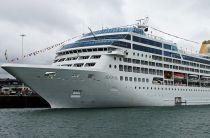East London (South Africa)
Cruise Port schedule, live map, terminals, news
Region
Africa - Indian Ocean Islands
Local Time
2025-12-13 04:11
 66°F
66°F 18.9°C

 Fresh breeze
Fresh breeze9.3 m/s
 71 °F / 22 °C
71 °F / 22 °C 63 °F / 18 °C
Port East London cruise ship schedule shows timetable calendars of all arrival and departure dates by month. The port's schedule lists all ships (in links) with cruises going to or leaving from East London, South Africa. To see the full itineraries (ports of call dates and arrival / departure times) and their lowest rates – just follow the corresponding ship-link.
| Day | Ship | Arrival | Departure |
|---|---|---|---|
| 1 December, 2025 Monday | 09:00 | 17:00 | |
| 26 December, 2025 Friday | 07:00 | 19:00 |
East London is a port city on South Africa's southeastern coast (Indian Ocean), in the Eastern Cape province. The city is located between Buffalo River and Nahoon River, thus having country's only river port. City's population is around 270,000 (metro over 755,000).
East London is province's 2nd largest seaport and industrial centre - after Port Elizabeth. The dominant employer is motor industry. A Daimler plant (Mercedes-Benz corporation) is located next to the harbour and manufactures Mercedes-Benz and other vehicles. They are produced here for the local market, and also for export to Brazil and USA. Other major industries include textiles, clothing, food processing, pharmaceuticals. To encourage investment in the city, in 2004 was established East London Industrial Development Zone (duty-free zone managed by East London IDZ Ltd). The 15 km2 (6 ml2) sized ELIDZ is on West Bank, close to both the airport and the seaport.
Resorts in East London include Areena, Cintsa East, Cintsa West, Glen Eden, Gonubie, Queensbury Bay and Yellowsands. Most popular tourist attractions include Museum, Zoo, Inkwenkwezi and Mpongo (private game reserves), Yellow Sands Caravan Park (camping). East London Museum has the unique coelacanth - prehistoric fish thought to be extinct, but in 1938 discovered live at Chalumna Mouth. The city is well known as skydiving and surfing destination, and its beaches are among the best in South Africa. The unique double-decker Buffalo River Bridge was built in 1931. It carries Arkansas Highway 7 (north–south state highway running across Arkansas State). The historic bridge has center span 49 m (160 ft) and total length 114 m (375 ft).
Port East London
Like all seaports in South Africa, East London port is managed by TNPA (Transnet National Ports Authority). This is a government corporation and division of Transnet Ltd (1990-founded, state-owned company specializing in freight rail transport, port terminal and pipeline management, logistics and engeneering).
TNPA manages seven of South Africa's largest seaports - Richards Bay, Durban, East London, Port Elizabeth, Mossel Bay, Cape Town, Ngqura, Saldanha. TNPA is also landlord responsible for master planning, marketing and developments, port navigation, services and facilities control. Transnet Port Terminals (division) manages port's terminal operations and cargo handling.
The port has 12 commercial berths (6 on West Bank, 6 on East Bank), 1 shiprepair quay (length 110 m / 360 ft), 1 pilot jetty, 1 fishing jetty. Port's total quayside is 2410 m (7910 ft). Port's entrance has max depth max draft 12 m (39 ft) and min width 170 m (560 ft). The max draft at berths (quayside) is between 8,5-10,5 m. Passenger ships (ferries and cruise liners) dock at whichever berth is currently available.
The port can handle ships with max LOA length 24 5m (804 ft). Port's anchorage area is located approx 1 mile east of the south breakwater. Pilotage is compulsory from approx 3 km northeast of the north breakwater. Tugboat assistance within the port is also compulsory. The port has 3 tugboats and 1 rescue craft . Marine services are available Monday to Friday (between 6 am - 10 pm).
The port has a dedicated grain terminal fitted with elevator and with storage (silo) capacity 76,000 tons - ranking it South Africa's largest. The modern tanker terminal serving oil tankers shipping unleaded petrol, auto diesel, kerosene (paraffin) and aviation fuel. Terminal's silo capacity is 7,6 million litres. The multi-purpose container terminal (on East Bank) handles container ships and has annual capacity 90,000 TEUs (containers). Port's drydock has capacity to handle vessels with max LOA length 200 m (656 ft) and max width 25 m (82 ft). Drydock's equipment includes 4 electric cranes plus 1 mobile crane.
The new car terminal (on West Bank) includes 4-storey parking which is connected via separate road to the adjacent Daimler factory. The new terminal has 2800 parking lots and annual capacity 50,000 cars. The facility is designed to allow future expansion (up to 8 storeys) with annual capacity 180,000 vehicles.
In 2017 were completed several infrastructure and equipment projects in East London Port, with total investment around ZAR 542 million (USD 40 million). The latest project was upgrade of the pile wharf (length 83 m / 270 ft) adjacent to Princess Elizabeth Dry Dock. The ZAR 108 million (USD 7,5 million) project was completed in October. The dock is used for both ship repairs and berthing of smaller ships,
Other completed in 2017 port development project was West Bank Foreshore protection (ZAR 176 million / USD 12 million). By this project was constructed a revetment to protect port’s infrastructure from erosion and wave actions. Also were upgraded tanker berth's fire protection system and port's security, port's rail network was replaced, Buffalo Bridge was refurbished.
Port's plans are to further enhance services and increase capacity by expanding the automotive facilities and upgrading maritime services. "Operation Phakisa" is a port development program (by country's government) to increase South Africa's marine shipping trade. By this program was refurbished the drydock (project cost ZAR 219 million / USD 15 million) and were also added new crane rails. Future projects include dredging (deepening and widening) of the entrance channel to improve manoeuvring and increase port's cargo capacity by allowing larger boxships (container carriers).
(statistics 2015) Port East London handled 330 ships, with total GT tonnage 11,475890 million tons, total cargo 2,945922 million tons (including TEUs), total bulk cargo 1,054352 million tons, breakbulk cargo 996,614 tons, total TEUs 66,293 (894,956 tons).
The car terminal was inaugurated in September 2000. Bunkering (fuel oil and marine gas oil) is via pipelines at berths S and T (West Bank). Cruise ships usually dock on East Bank berths.
Port East London's cargo and cruise shipping operations are managed by TNPA (Transnet National Ports Authority). This is Africa's largest port authority company that manages 7 large seaports in South Africa - East London, Durban, Cape Town, Richards Bay, Mossel Bay, Port Elizabeth, and Saldanha.
- Cruise Industry

Azamara announces 44 new winter 2024-2025 itineraries
The upmarket cruise line and leader in Destination Immersion experiences Azamara announced 44 new cruises for Winter 2024-2025 spanning the world's 4...
November 12, 2022 - Cruise Industry

Azamara Cruises restarts in South Africa with Azamara Pursuit January-March 2022
Azamara Cruises announced its return to South Africa, as the country reopens international cruising. Azamara Pursuit is scheduled to set sail from...
October 6, 2021 - Cruise Industry

Cruise and Maritime Voyages Introduce Grand Round the World Cruise 2021
Sailing via the Azores and Caribbean, Cruise and Maritime Voyages-CMV's Columbus is scheduled to transit the Panama Canal visiting the islands of the...
November 3, 2019 - show more news
